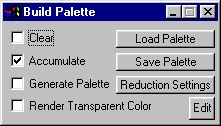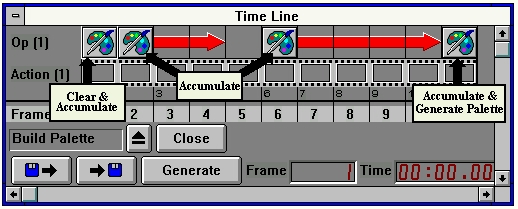| This is a child page. You can use Parent in the quick nav bar at the top or the bottom of the page to navigate directly back to the parent of this page. Some child pages are more than one level deep, and in that case will require more than one Parent click to reach the outermost document level. |
§ 16.110 - Build Palette
| Quick Reference to Scripting Command |
| a=BUILDPAL(CLEAR, ACCUMULATE, GENERATE, RENDER TRANSPARENT COLOR) |
| Items in CAPS are 0/1 or ranges with more options than just 0/1. Ranges other than 0/1 are indicated by brackets, such as [0-2]. |

The Build palette operation is used to develop an animation palette from a number of images. This allows animators to "render down" a sequence of images into a palette which can be used for all of the frames in the animation. The operation has three states or actions: Clear, Accumulate, and Generate Palette.
These options relate to how F/x and the TimeLine will treat the action images in regard to the image's palette.
- The ✓ Clear option is used to clear the palette collection buffer, and is usually only used once at the beginning of a TimeLine sequence, but it is not limited to this position.
- The ✓ Accumulate option will determine which colors are represented in the image, and is usually used for every frame in the TimeLine. The colors in the image are simply placed into the palette collection buffer. This is done for all of the frames that you wish to obtain color information from.
- The ✓ Generate Palette option will review all of the colors that have been gathered from all of the images, and then it will develop a single palette in the specified number of colors. This option is generally used in only the last frame of a sequence.
Each of these controls and all of the other Build Palette dialog controls are explained below in the detailed documentation section.
§ 16.110.1 - Build Palette TimeLine Example
A typical build palette TimeLine will have three separate build palette icons, and a number of image files. The first frame, in most cases, will contain a build palette operation set to ✓ Clear and ✓ Accumulate This will clear all of the colors from the current color collection buffer, and also accumulate colors from the action image in frame 1 of the TimeLine. The colors collected or selected by the accumulate operation are determined by the actual colors in the image. Colors are simply placed into the buffer with no specific weight or significance.
This is done for all frames that should be included in the final palette selection. The next icon in the TimeLine should use ✓ Accumulate only. This will cause F/x to accumulate color information from each of the specified animation files, and then store that information in the color collection buffer. You have the option of skipping frames by decreasing the operation arrow associated with the operation icon.
For example, the TimeLine below does not use the 5th image in the accumulation of colors. The accumulation resumes with frame 6. The last operation is an ✓ Accumulate and ✓ Generate Palette option. This will gather the color information from the final image, and then select the overall best palette from all of the accumulated colors. The number of colors that this operation selects directly relates to the Number of Colors setting in the Output Color Reduction dialog. This value can range from 1 to 256.
The colors are then placed into the render palette, on the basis of the color usage settings for each color cell (see output color reduction). In general you will not want to use the TimeLine Save Results option while gathering a render palette. Instead, you should sequence the frames (as shown), and then re-render and save the frames with the newly selected render palette.
§ 16.110.2 - Generating a Palette for a Single Image
In some cases you may find it necessary to generate a palette for only one frame. This can be done very simply by setting all of the Build Palette optiona On (✓ Clear , ✓ Accumulate , and ✓ Generate Palette ). After you have switched all of these options on, you would select the Entire area selection mode, and click in the image that you wish to gather a palette from. F/x will then clear the collection buffer, accumulate all of the colors in the image, and generate a palette based on the number of colors specified in the output color reduction dialog. After the operation has finished, the new render palette can be viewed by pressing the Edit button in the Build Palette dialog. All of the newly selected colors will appear in the Color Usage area in the middle of the dialog. You can then save the palette for later use.
§ 16.110.3 - Build Palette Controls
§ 16.110.3.1 - Clear
The Clear option will clear all of the currently stored colors in the color collection buffer. This is generally reserved for the first frame in a Timeline, but can be used for any frame. Once the collection buffer has been cleared, it cannot be retrieved. Please review the previous sections for proper usage of the Clear option in a Timeline.
§ 16.110.3.2 - Accumulate
The accumulate mode will go through all of the specified images, and collect color information from these images. This information is placed into a color collection buffer where all of the colors from all of the images are temporarily stored. After all of the images have been processed, the Generate Palette option will pick the best representative colors from the collection buffer. The accumulate option is used for almost every frame in a Timeline, but can be turned off for any relevant frame or frames. Review the sections above for proper usage of the accumulate option in the Timeline.
§ 16.110.3.3 - Generate Palette
This option will create a palette of colors based on the colors in the color collection buffer, and the setting of the Number of Colors option in the Output Color Reduction panel. For example, if you set the Number of Colors option to 64, Generate Palette would select the best 64 colors from the color collection buffer. After these colors have been selected, they would be placed into the render palette based on the current usage status of the first 64 colors (see the output color reduction section for more on color usage). As stated above, this option is generally reserved for the last frame of a Timeline, but it can also be used to obtain a palette from a single image.
§ 16.110.3.4 - Load Palette
The Load Palette button will load any previously saved palette as the current render palette. It is important to remember that render and effects palettes are kept separate in the program. For example, loading a palette via this option will effect only the render palette, not the effects palette. F/x loads multiple palette formats including: Microsoft Windows Paintbrush palettes, AVI (Video for Windows) palettes, Bitmap palettes, Adobe Color Table (ACT) palettes, and IFF palettes.
§ 16.110.3.5 - Save Palette
The Save Palette option allows you to save the current render palette in the standard F/x palette format. Once a render palette has been saved, it can be reloaded using the load palette option in either a render or effects palette.
§ 16.110.3.6 - Reduction Settings
This button will access the Output Color Reduction dialog. This dialog contains an area that allows the user to select which colors should be selected. This dialog can be left open and edited while you are setting up a Build Palette operation, and it will automatically reflect any changes that you make to the render palette.
§ 16.110.3.7 - Edit
This button will access the palette generated by the operation. This allows you to examine and edit its contents before saving the palette.
§ 16.110.3.8 - Render Transparent Color
This option allows you to create GIF images with transparency. This reserves a transparent entry in the palette, now GIF images saved with that palette will be transparent where the image alpha was 0.
, Previous Page . Next Page t TOC i Index o Operators g Glossary
Copyright © 1992-2007 Black Belt Systems ALL RIGHTS RESERVED Under the Pan-American Conventions
WinImages F/x Manual Version 7, Revision 6, Level A

